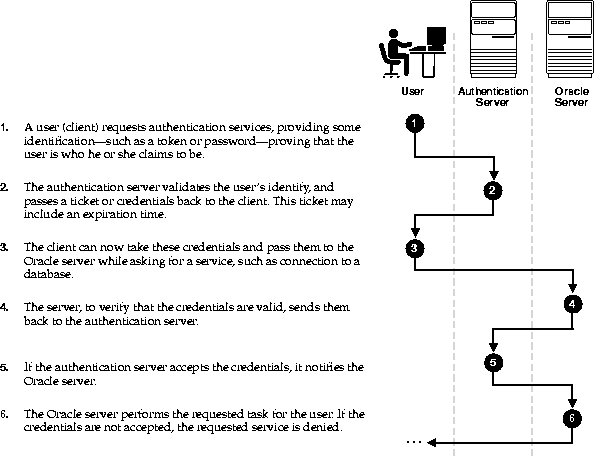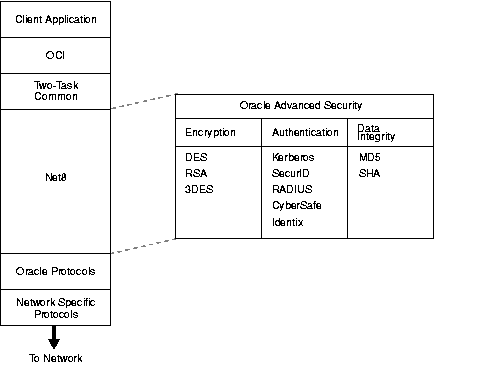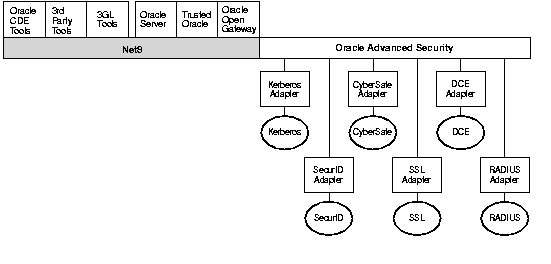Release 8.1.7
Part Number A85430-01
Library |
Product |
Contents |
Index |
| Oracle Advanced Security Administrator's Guide Release 8.1.7 Part Number A85430-01 |
|
This chapter introduces Oracle Advanced Security and describes its features. These features are available to database and related products that interface with Oracle Net8, including Oracle8i, Oracle Designer, and Oracle Developer.
This chapter contains the following sections:
Oracle Advanced Security provides a comprehensive suite of security features to protect enterprise networks and securely extend corporate networks to the Internet. It provides a single source of integration with network encryption and authentication solutions, single sign-on services, and security protocols. By integrating industry standards, it delivers unparalleled security to the Oracle network.
This section contains the following topics:
Oracle databases power the largest and most popular web sites on the Internet. In record numbers, organizations throughout the world are deploying distributed databases and client/server applications based on Oracle8i and Net8. This proliferation of distributed computing is matched by an increase in the amount of information that organizations place on computers. Employee and financial records, customer orders, product information, and other sensitive data have moved from filing cabinets to file structures. The volume of sensitive information on the web has thus increased the value of data that can be compromised.
The increased volume of data in distributed environments exposes users to a variety of security threats, including the following:
Over the Internet and in wide area network environments, both public carriers and private networks route portions of their network through insecure land lines, vulnerable microwave and satellite links, or a number of servers-- exposing valuable data to interested third parties. In local area network environments within a building or campus, the potential exists for insiders with access to the physical wiring to view data not intended for them, and network sniffers can be installed to eavesdrop on network traffic.
Distributed environments bring with them the possibility that a malicious third party can compromise integrity by tampering with data as it moves between sites.
In a distributed environment, it is more feasible for a user to falsify an identity to gain access to sensitive information. How can you be sure that user Pat connecting to Server A from Client B really is user Pat?
Moreover, in distributed environments, malefactors can hijack connections. How can you be sure that Client B and Server A are what they claim to be? A transaction that should go from the Personnel system on Server A to the Payroll system on Server B could be intercepted in transit and re-routed to a terminal masquerading as Server B.
In large systems, users typically must remember multiple passwords for the different applications and services that they use. For example, a developer can have access to a development application on a workstation, a PC for sending email, and several computers or intranet sites for testing, reporting bugs, and managing configurations.
Users typically respond to the problem of managing multiple passwords in several ways:
All of these strategies compromise password secrecy and service availability. Moreover, administration of multiple user accounts and passwords is complex, time-consuming, and expensive.
Oracle Advanced Security provides data privacy, integrity, authentication, single sign-on, and access authorization in a variety of ways.
For example, you can configure either Net8 native encryption or Secure Socket Layer (SSL) for data privacy. Oracle Advanced Security also provides the choice of several strong authentication methods, including Kerberos, smart cards, and digital certificates.
Oracle Advanced Security features are described in the following sections:
Oracle Advanced Security protects the privacy of data transmissions through the following encryption methods:
Selection of the network encryption method is a user configuration option, providing varying levels of security and performance for different types of data transfers.
Prior versions of Oracle Advanced Security provided three editions: Domestic, Upgrade, and Export--each with different key lengths. Release 8.1.7 now contains a complete complement of the available encryption algorithms and key lengths, previously only available in the Domestic edition. Users deploying prior versions of the product can obtain the Domestic edition for a specific product release.
The RSA encryption module uses the RSA Security, Inc. RC4 encryption algorithm. Using a secret, randomly-generated key unique to each session, all network traffic is fully safeguarded--including all data values, SQL statements, and stored procedure calls and results. The client, server, or both, can request or require the use of the encryption module to guarantee that data is protected. Oracle's optimized implementation provides a high degree of security for a minimal performance penalty. For the RC4 algorithm, Oracle provides encryption key lengths of 40-bits, 56-bits, 128-bits, and 256-bits.
The U.S. Data Encryption Standard algorithm (DES) uses symmetric key cryptography to safeguard network communcations. Oracle Advanced Security implements DES with a standard, optimized 56-bit key encryption algorithm, and also provides DES40, a 40-bit version, for backwards compatibility.
Oracle Advanced Security also supports Triple-DES encryption (3DES), which encrypts message data with three passes of the DES algorithm. 3DES provides a high degree of message security, but with a performance penalty--the magnitude of which is dependant upon on the speed of the processor performing the encryption; 3DES typically takes three times as long to encrypt a data block as compared with the standard DES algorithm.
3DES is available in two-key and three-key versions, with effective key lengths of 112-bits and 168-bits, respectively. Both versions operate in outer Cipher Block Chaining (CBC) mode.
Oracle Advanced Security Release 8.1.7 has been validated under U.S. Federal Information Processing Standard 140-1 (FIPS) at the Level 2 security level. This provides independent confirmation that Oracle Advanced Security conforms to federal government standards. FIPS configuration settings are described by Appendix D, Oracle Advanced Security FIPS 140-1 Settings.
To ensure the integrity of data packets during transmission, Oracle Advanced Security can generate a cryptographically secure message digest--using MD5 or SHA encryption algorithms--and include it with each message sent across a network.
Data integrity algorithms add little overhead, and protect against the following attacks:
Authenticating user identity is imperative in distributed environments, without which there can be little confidence in network security. Passwords are the most common authentication method, and Oracle Advanced Security provides enhanced user authentication through several third-party authentication services, and through the use of SSL and digital certificates (See: Figure 1-1).
Many Oracle Advanced Security authentication methods use centralized authentication. This can give you high confidence in the identity of users, clients, and servers in distributed environments. Having a central facility authenticate all members of the network (clients to servers, servers to servers, users to both clients and servers) is one effective way to address the threat of nodes on a network falsifying their identities.
Figure 1-1 shows how a centralized network authentication service typically operates:

Oracle Advanced Security supports the following authentication methods:
Secure Sockets Layer (SSL) is an industry standard protocol for securing network connections. SSL provides authentication, data encryption, and data integrity, and it contributes to a public-key infrastructure (PKI).
Oracle Advanced Security SSL can be used to secure communications between any client and any server. You can configure SSL to provide server authentication only, client authentication only, or both client and server authentication.
SSL uses digital certificates (X.509 v3), and a public/private key pair to authenticate users and systems.
SSL features can be used by themselves or in combination with other authentication methods supported by Oracle Advanced Security.
Oracle Advanced Security supports the public key infastructure (PKI) provided by the Entrust/PKI software provided by Entrust Technologies, Inc. Entrust-enabled Oracle Advanced Security allows Entrust users to incorporate Entrust single sign-on into their Oracle applications, and Oracle users to incorporate Entrust-based single sign-on into Oracle applications.
Remote Authentication Dial-In User Service (RADIUS) is a client-server security protocol that is most widely known for enabling remote authentication and access. Oracle Advanced Security uses this standard in a client-server network environment to enable use of any authentication method that supports the RADIUS protocol. RADIUS can be used with a variety of authentication mechanisms, including token cards, smart cards, and biometrics.
Oracle Advanced Security support for Kerberos and CyberSafe provides the benefits of single sign-on and centralized authentication of Oracle users. Kerberos is a trusted third-party authentication system that relies on shared secrets. It presumes that the third party is secure, and provides single sign-on capabilities, centralized password storage, database link authentication, and enhanced PC security. It does this through a Kerberos authentication server, or through CyberSafe TrustBroker, a commercial Kerberos-based authentication server.
A RADIUS-compliant smart card is a credit card-like hardware device. It has memory and a processor and is read by a smart card reader located at the client workstation.
Smart cards provide the following benefits:
Token cards (SecurID or RADIUS-compliant) can improve ease of use through several different mechanisms. Some token cards dynamically display one-time passwords that are synchronized with an authentication service. The server can verify the password provided by the token card at any given time by contacting the authentication service. Other token cards have a keypad and operate on a challenge-response basis. In this case, the server offers a challenge (a number) that the user enters into a token card. The token card provides a response (another number cryptographically derived from the challenge) that the user enters and sends to the server.
Token cards provide the following benefits:
You can use SecurID tokens through either the SecurID adapter or through RADIUS.
Identix Biometric Authentication (Identix or RADIUS-compliant) is used on both Oracle clients and servers to communicate fingerprint-based authentication data between the authentication server and the clients. Other biometric authentication devices that are RADIUS compliant can integrate with Oracle Advanced Security using RADIUS to authenticate Oracle users.
Bull Integrated System Management (ISM), from Bull Worldwide Information Systems, provides a variety of management tools for system administrators. This authentication method is available on the AIX operating system only.
Centralized authentication can enable a single, integrated user sign-on (single sign-on). This feature lets users access multiple accounts and applications with a single password, eliminates the need for multiple passwords, and simplifies management of user accounts and passwords for system administrators.
Oracle Advanced Security single sign-on authenticates the user once upon initial connection, with strong authentication occurring transparently in subsequent connections to other databases or services. Using single sign-on, users can access multiple accounts and applications with a single password. Oracle Advanced Security supports many forms of single sign-on, including Kerberos and CyberSafe.
Oracle Advanced Security also provides SSL-based single sign-on for Oracle users by integrating with LDAP v3-compliant directory services. The combination of integrated directory services and Oracle's PKI implementation enable SSL-based single sign-on to Oracle8i databases. Single sign-on lets users be authenticated once, with subsequent connections relying on the user's digital certificate.
This enhances ease-of-use for users, and provides centralized management to security administrators.
User authorization, a function of Oracle8i roles and privileges, is significantly enhanced by using the authentication methods supported by Oracle Advanced Security. For example, on certain operating systems, such as Solaris, Oracle Advanced Security supports authorization with DCE.
Authorizations are also provided by Oracle Advanced Security Enterprise User Security (See: Chapter 17, Managing Enterprise User Security). Oracle Advanced Security can integrate with LDAP version 3-compliant directories to centrally manage users and authorizations. Your Oracle Advanced Security license entitles you to deploy Oracle Internet Directory for user management as well as authorization storage and retrieval. You must license Oracle Internet Directory separately if you use it for additional purposes.
Oracle Advanced Security is an add-on product that complements a standard Oracle server or client installation. Figure 1-2 shows the Oracle Advanced Security architecture within an Oracle networking environment.

Oracle Advanced Security supports authentication through adapters that are very much like the existing Oracle protocol adapters. As shown in Figure 1-3, authentication adapters integrate below the Net8 interface and allow existing applications to take advantage of new authentication systems transparently, without any changes to the application.

Oracle Advanced Security is fully supported by Oracle Connection Manager, making secure data transfer a reality across network protocol boundaries. Clients using LAN protocols such as NetWare (SPX/IPX), for example, can securely share data with large servers using different network protocols such as LU6.2, TCP/IP, or DECnet. To eliminate potential weak points in the network infrastructure and to maximize performance, Connection Manager passes encrypted data from protocol to protocol without the cost and exposure of decryption and re-encryption.
Oracle Advanced Security is an add-on product bundled with the standard Oracle Net8 Server or Net8 Client. It must be purchased and installed on both the client and the server.
Oracle Advanced Security release 8.1.7 requires Net8 release 8.1.7 and supports Oracle8i Enterprise Edition. Table 1-1 lists additional system requirements.
Table 1-1 Authentication Methods and System Requirements
Oracle Applications support Oracle Advanced Security encryption and data integrity. However, because Oracle Advanced Security requires Net8 to transmit data securely, Oracle Advanced Security external authentication features are not supported by some parts of Oracle Financial, Human Resource, and Manufacturing Applications when they are running on Microsoft Windows. The portions of these products that use Oracle Display Manager (ODM) do not take advantage of Oracle Advanced Security, since ODM does not use Net8.
|
|
 Copyright © 1996-2000, Oracle Corporation. All Rights Reserved. |
|